Patterns of Richness and Endemism in the Gypsicolous Flora of Mexico
Abstract
1. Introduction
2. Materials and Methods
2.1. Botanical Records on Mexican Gypsum Soils
2.2. Species Richness
2.3. Endemism
2.4. Conservation Status of the Mexican Gypsicolous Flora
3. Results
3.1. Botanical Records on Mexican Gypsum Soils
3.2. Species Richness
3.3. Endemism
3.4. Conservation Status of the Mexican Gypsicolous Flora
4. Discussion
4.1. Botanical Records on Mexican Gypsum Soils
4.2. Species Richness
4.3. Endemism
4.4. Conservation Status of the Mexican Gypsicolous Flora
5. Conclusions
Author Contributions
Funding
Data Availability Statement
Acknowledgments
Conflicts of Interest
References
- Herrero, J.; Porta, J. The terminology and the concepts of gypsum-rich soils. Geoderma 2000, 96, 47–61. [Google Scholar] [CrossRef]
- Herrero, J. Revisiting the definitions of gypsic and petrogypsic horizons in soil taxonomy and world reference base for soil resources. Geoderma 2004, 120, 1–5. [Google Scholar] [CrossRef]
- Mota, J.F.; Sánchez-Gómez, P.; Guirado, J.S. Diversidad Vegetal de las Yeseras Ibéricas, 1st ed.; DIF-Mediterráneo Asesores Consultores: Almería, Spain, 2011. [Google Scholar]
- Pérez-García, F.J.; Martínez-Hernández, F.; Mendoza-Fernández, A.J.; Merlo, M.E.; Sola, F.; Salmerón-Sánchez, E.; Garrido-Becerra, J.A.; Mota, J.F. Towards a global checklist of the world gypsophytes: A qualitative approach. Plant Sociol. 2017, 54 (Suppl. S1), 61–76. [Google Scholar]
- Turner, B.L.; Powell, A.M. Deserts, gypsum and endemism. In Arid Land Plant Resources, 1st ed.; Goodin, J.R., Northington, D.K., Eds.; International Center for Arid and Semi-Arid Land Studies, Tech University: Lubbock, TX, USA, 1979; pp. 9–116. [Google Scholar]
- Moore, M.J.; Mota, J.F.; Douglas, N.A.; Flores-Olvera, H.; Ochoterena, H. The ecology, assembly and evolution of gypsophile floras. In Plant Ecology and Evolution in Harsh Environments, 1st ed.; Rajakaruna, N., Boyd, R.S., Harris, T.B., Eds.; Nova Science Publishers: Hauppauge, NY, USA, 2014; pp. 97–128. [Google Scholar]
- Escudero, A.; Palacio, S.; Maestre, F.T.; Luzuriaga, A.L. Plant life on gypsum: A review of its multiple facets. Biol. Rev. 2014, 90, 1–18. [Google Scholar] [CrossRef]
- Johnston, I.M. Gypsophily among mexican desert plants. J. Arnold Arbor. 1941, 22, 145–170. [Google Scholar] [CrossRef]
- SGM, Servicio Geológico Mexicano. Cartas Geológico-Mineras, Escala 1:500,000. Available online: https://www.sgm.gob.mx/CartasPdf/GeologicasL.jsp (accessed on 10 September 2022).
- Rzedowski, J. Vegetación de México, 1st ed.; Editorial Limusa: Mexico City, Mexico, 1978. [Google Scholar]
- Czaja, A.; Estrada-Rodríguez, J.L.; Flores-Olvera, H. The gypsum dunes of Cuatrociénegas Valley, Mexico: A secondary sabkha ecosystem with gypsophytes. In Sabkha Ecosystems: Volume IV: Cash Crop Halophyte and Biodiversity Conservation, 1st ed.; Ajmal-Khan, M., Böer, B., Öztürk, M., Al-Abdessalaam, T.Z., Clüsener-Godt, M., Gul, B., Eds.; Springer: Berlin/Heidelberg, Germany, 2014; pp. 81–92. [Google Scholar]
- Morrone, J.J.; Escalante, T.; Rodríguez-Tapia, G. Mexican biogeographic provinces: Map and shapefiles. Zootaxa 2017, 4277, 277–279. [Google Scholar] [CrossRef]
- Moore, M.J.; Jansen, R.K. Origins and biogeography of gypsophily in the Chihuahuan Desert plant group Tiquilia subg. Eddya (Boraginaceae). Syst. Bot. 2007, 32, 392–414. [Google Scholar] [CrossRef]
- Felger, R.S.; Wilder, B.T.; Romero-Morales, H. Plant Life of a Desert Archipelago: Flora of the Sonoran Islands in the Gulf of California, 1st ed.; University of Arizona Press: Tucson, AZ, USA, 2012. [Google Scholar]
- Martínez, E.; Galindo-Leal, C. La vegetación de Calakmul, Campeche, México: Clasificación, descripción y distribución. Bot. Sci. 2002, 71, 7–32. [Google Scholar] [CrossRef]
- McVaugh, R.; Mickel, J.T. Notes on Pinguicula, sect. Orcheosanthus. Brittonia 1963, 15, 134–140. [Google Scholar] [CrossRef]
- Harker, M.; Hernández-López, L.; Muñiz-Castro, M.A. Flora del bosque tropical caducifolio en una zona con suelos yesosos y calcáreos de Colima, México. Acta Bot. Mex. 2021, 128, e1818. [Google Scholar] [CrossRef]
- Vázquez-García, J.A.; Muñiz-Castro, M.A.; Sahagún-Godínez, E.; Cházaro-Basáñez, M.J.; De Castro-Arce, E.; Nieves-Hernández, G.; Padilla-Lepe, J. Four new species of Agave (Agavaceae) of the Marmoratae group. Syst. Bot. 2013, 38, 1–12. [Google Scholar] [CrossRef]
- Ramírez-Morillo, I.; Carrillo-Reyes, P.; Tapia-Muñoz, J.L.; Cetzal-Ix, W. An addition to genus Hechtia (Hechtioideae; Bromeliaceae) from Jalisco, Mexico. Phytotaxa 2016, 266, 261–270. [Google Scholar] [CrossRef]
- Alfaro-Sánchez, G. Suelos. In Biodiversidad de Oaxaca, 1st ed.; García-Mendoza, A.J., Ordóñez, M.J., Briones-Salas, M., Eds.; Universidad Nacional Autónoma de México: Mexico City, Mexico, 2004; pp. 55–66. [Google Scholar]
- García-Mendoza, A.J.; Sandoval-Gutiérrez, D.; Redonda-Martínez, R. Mixtecalia, a new monotypic genus of the subtribe Tussilagininae (Senecioneae, Asteraceae) from the state of Oaxaca, Mexico. Phytotaxa 2020, 438, 119–129. [Google Scholar] [CrossRef]
- Cervantes-Maldonado, A.; Flores-Olvera, H.; Valdés, J. Las Euphorbiaceae halófilas y gipsófilas de México, excepto Euphorbia. Anales Inst. Biol. Univ. Nac. Autón. México Bot. 2001, 72, 1–83. [Google Scholar]
- Romão, R.L.; Escudero, A. Gypsum physical soil crusts and the existence of gypsophytes in semi-arid central Spain. Plant Ecol. 2005, 181, 127–137. [Google Scholar] [CrossRef]
- Drohan, P.J.; Merkler, D.J. How do we find a true gypsophile? Geoderma 2009, 150, 96–105. [Google Scholar] [CrossRef]
- Parsons, R.F. Gypsophily in plants: A review. Am. Midl. Nat. 1976, 96, 1–20. [Google Scholar] [CrossRef]
- Mota, J.F.; Garrido-Becerra, J.A.; Pérez-García, F.J.; Salmerón-Sánchez, E.; Sánchez-Gómez, P.; Merlo, E. Conceptual baseline for a global checklist of gypsophytes. Lazaroa 2016, 37, 7–30. [Google Scholar] [CrossRef]
- Meyer, S.E. The ecology of gypsophile endemism in the eastern Mojave Desert. Ecology 1986, 67, 1303–1313. [Google Scholar] [CrossRef]
- Palacio, S.; Cera, A.; Escudero, A.; Luzuriaga, A.L.; Sánchez, A.M.; Mota, J.F.; Pérez-Serrano Serrano, M.; Merlo, M.E.; Martínez-Hernández, F.; Salmeron-Sánchez, E.; et al. Recent and ancient evolutionary events shaped plant elemental composition of edaphic endemics: A phylogeny-wide analysis of Iberian gypsum plants. New Phytol. 2022, 235, 2406–2423. [Google Scholar] [CrossRef]
- Rubio, A.; Escudero, A. Small-scale spatial soil-plant relationship in semi-arid gypsum environments. Plant Soil 2000, 220, 139–150. [Google Scholar] [CrossRef]
- Meyer, S.E.; García-Moya, E.; Lagunes-Espinoza, L.C. Topographic and soil surface effects on gypsophile plant community patterns in central Mexico. J. Veg. Sci. 1992, 3, 429–438. [Google Scholar] [CrossRef]
- Yeaton, R.I.; Flores-Flores, J.L. Patterns of occurrence and abundance in colony complexes of the Mexican prairie dog (Cynomis mexicanus) in productive and unproductive grasslands. Acta Zool. Mex. 2006, 22, 107–130. [Google Scholar] [CrossRef]
- Luévano, J.; Mellink, E.; Riojas-López, M.E.; Flores-Flores, J.L. Comunidades de roedores nocturnos en un ecotono de matorrales micrófilos y zacatal gipsófilo en San Luis Potosí, México. Rev. Mex. Biodivers. 2008, 79, 197–203. [Google Scholar] [CrossRef]
- Estrada-Castillón, E.; Scott-Morales, L.; Villarreal-Quintanilla, J.A.; Jurado-Ybarra, E.; Cotera-Correa, M.; Cantú-Ayala, C.; García-Pérez, J. Clasificación de los pastizales halófilos del noreste de México asociados con perrito de las praderas (Cynomys mexicanus): Diversidad y endemismo de especies. Rev. Mex. Biodivers. 2010, 81, 401–416. [Google Scholar] [CrossRef]
- Pinkava, D.J. Vegetation and flora of the Bolson of Cuatro Cienegas Region, Coahuila, Mexico: IV. Summary, endemism and corrected catalogue. J. Ariz. Nev. Acad. Sci. 1984, 19, 23–47. [Google Scholar]
- Arias, S.; Tapia, H.J.; Guzmán, U. A new species of Cephalocereus (Cactaceae) from southern Mexico. Phytotaxa 2019, 392, 147–156. [Google Scholar] [CrossRef]
- Valdés, J.; Flores, H. Las gimnospermas en la flora halófila y gipsófila de México. Anales Inst. Biol. Univ. Nac. Autón. México Bot. 1986, 57, 45–58. [Google Scholar]
- Alanís-Flores, G.J.; Alvarado-Vázquez, M.A.; Ramírez-Freire, L.; Velazco-Macías, C.G.; Foroughbakhch-Pournavab, R. Flora endémica de Nuevo León, México y estados colindantes. J. Bot. Res. Inst. Tex. 2011, 5, 275–298. [Google Scholar]
- Powell, A.M.; Turner, B.L. Aspects of the plant biology of the gypsum outcrops of the Chihuahuan Desert. In Transactions of the Symposium on the Biological Resources of the Chihuahuan Desert Region, United States and Mexico, Sul Ross State University, Alpine, Texas, 17–18 October 1974, 1st ed.; Wauer, R.H., Riskind, D.H., Eds.; Transactions and Proceedings Series, Number 3; U.S. Department of the Interior, National Park Service: Washington, DC, USA, 1977; pp. 315–325. [Google Scholar]
- Villarreal-Quintanilla, J.A.; Encina-Domínguez, J.A. Plantas vasculares endémicas de Coahuila y algunas áreas adyacentes, México. Acta Bot. Mex. 2005, 70, 1–46. [Google Scholar] [CrossRef]
- De-Nova, J.A.; Castillo-Lara, P.; Gudiño-Cano, A.K.; García-Pérez, J. Flora endémica del estado de San Luis Potosí y regiones adyacentes en México. Árido-Ciencia 2018, 3, 21–41. [Google Scholar]
- Hinton, G.S.; Villaseñor, J.L.; Ortiz, E. The Hintons’ legacy to the knowledge of the flora of Mexico. Bot. Sci. 2019, 97, 447–538. [Google Scholar] [CrossRef]
- Valdés, J.; Flores, H. Las pteridofitas en la flora halófila y gipsófila de México. Anales Inst. Biol. Univ. Nac. Autón. México Bot. 1983, 54, 173–188. [Google Scholar]
- Sánchez-Del Pino, I.; Flores Olvera, H.; Valdés, J. La familia Amaranthaceae en la flora halófila y gipsófila de México. Anales Inst. Biol. Univ. Nac. Autón. México Bot. 1999, 70, 29–135. [Google Scholar]
- Ochoterena, H.; Flores-Olvera, H.; Gómez-Hinostrosa, C.; Moore, M.J. Chapter 9: Gypsum and plant species: A marvel of Cuatro Ciénegas and the Chihuahuan Desert. In Plant Diversity and Ecology in the Chihuahuan Desert, Cuatro Ciénegas Basin: An Endangered Hyperdiverse Oasis, 1st ed.; Mandujano, M.C., Pisanty, I., Eguiarte, L.E., Eds.; Springer: Cham, Switzerland, 2020; pp. 129–165. [Google Scholar] [CrossRef]
- Salazar, G.A.; Chávez-Rendón, C.; de Ávila-B, A.; Jiménez-Machorro, R. Floral similarity and vegetative divergence in a new species of Bletia (Orchidaceae) from Mexico. Phytotaxa 2016, 275, 112–126. [Google Scholar] [CrossRef]
- Rivadavia, F.; Lloyd-Read, E.; Fleischmann, A. Pinguicula pygmaea (Lentibulariaceae), a new annual gypsicolous species from Oaxaca State, Mexico. Phytotaxa 2017, 292, 279–286. [Google Scholar] [CrossRef]
- García-Mendoza, A.J.; Franco-Martínez, I.S.; Sandoval-Gutiérrez, D. Cuatro especies nuevas de Agave (Asparagaceae, Agavoideae) del sur de México. Acta Bot. Mex. 2019, 126, e1461. [Google Scholar] [CrossRef]
- Hernández-Cárdenas, R.A.; López-Ferrari, A.R.; Espejo-Serna, A. Two new species of Hechtia (Bromeliaceae, Hechtioideae) from Oaxaca, Mexico. Phytotaxa 2019, 397, 280–290. [Google Scholar] [CrossRef]
- Reznicek, A.A.; González-Elizondo, M.; Hahn, M.; Garner, M.; Hipp, A.L. Monograph of Carex section Schiedeanae (Cyperaceae): Unexpected taxonomic and ecological diversity in Mexican sedge clade. J. Syst. Evol. 2021, 59, 698–725. [Google Scholar] [CrossRef]
- Sosa, V.; De-Nova, J.A. Endemic angiosperm lineages in Mexico: Hotspots for conservation. Acta Bot. Mex. 2012, 100, 293–315. [Google Scholar] [CrossRef]
- Salinas-Rodríguez, M.M.; Sajamab, M.J.; Gutiérrez-Ortega, J.S.; Ortega-Baes, P.; Estrada-Castillón, A.E. Identification of endemic vascular plant species hotspots and the effectiveness of the protected areas for their conservation in Sierra Madre Oriental, Mexico. J. Nat. Conserv. 2018, 46, 6–27. [Google Scholar] [CrossRef]
- Hawkins, B.A.; Rodríguez, M.A.; Weller, S.G. Global angiosperm family richness revisited: Linking ecology and evolution to climate. J. Biogeogr. 2011, 38, 1253–1266. [Google Scholar] [CrossRef]
- Thiers, B. Index Herbariorum: A Global Directory of Public Herbaria and Associated Staff. New York Botanical Garden’s Virtual Herbarium. Available online: http://sweetgum.nybg.org/science/ih (accessed on 4 August 2022).
- GBIF, Global Biodiversity Information Facility. Available online: www.gbif.org (accessed on 13 August 2019).
- IBdata, Instituto de Biología de la Universidad Nacional Autónoma de México. Available online: http://www.ibdata.ib.unam.mx/web/ (accessed on 25 August 2019).
- Salinas-Rodríguez, M.M.; Estrada-Castillón, E.; Villarreal-Quintanilla, J.A. Endemic vascular plants of the Sierra Madre Oriental, Mexico. Phytotaxa 2017, 328, 1–52. [Google Scholar] [CrossRef]
- Rodríguez, A.; Castro-Castro, A.; Vargas-Amado, G.; Vargas-Ponce, O.; Zamora-Tavares, P.; González-Gallegos, J.; Carrillo-Reyes, P.; Anguiano-Constante, M.; Carrasco-Ortiz, M.; García-Martínez, M.; et al. Richness, geographic distribution patterns, and areas of endemism of selected angiosperm groups in Mexico. J. Syst. Evol. 2018, 56, 537–549. [Google Scholar] [CrossRef]
- Aragón-Parada, J.; Rodríguez, A.; Munguía-Lino, G.; De-Nova, J.A.; Salinas-Rodríguez, M.M.; Carrillo-Reyes, P. Las plantas vasculares endémicas de la Sierra Madre del Sur, México. Bot. Sci. 2021, 99, 643–660. [Google Scholar] [CrossRef]
- Boyle, B.; Hopkins, N.; Lu, Z.; Raygoza-Garay, J.A.; Mozzherin, D.; Rees, T.; Matasci, N.; Narro, M.L.; Piel, W.H.; Mckay, S.J.; et al. The taxonomic name resolution service: An online tool for automated standardization of plant names. BMC Bioinform. 2013, 14, 16. [Google Scholar] [CrossRef]
- Angiosperm Phylogeny Group. An update of the Angiosperm Phylogeny Group classification for the orders and families of flowering plants: APG IV. Bot. J. Linn. Soc. 2016, 181, 1–20. [Google Scholar] [CrossRef]
- Christenhusz, M.J.M.; Reveal, J.L.; Farjon, A.; Gardner, M.F.; Mill, R.R.; Chase, M.W. A new classification and linear sequence of extant gymnosperms. Phytotaxa 2011, 19, 55–70. [Google Scholar] [CrossRef]
- Christenhusz, M.J.M.; Zhang, X.C.; Schneider, H. A linear sequence of extant families and genera of lycophytes and ferns. Phytotaxa 2011, 19, 7–54. [Google Scholar] [CrossRef]
- QGIS Development Team. QGIS Geographic Information System. Open-Source Geospatial Foundation Project, Boston, USA. Available online: https://www.qgis.org/es/site/ (accessed on 14 September 2019).
- Hijmans, R.J.; Guarino, L.; Bussink, C.; Mathur, P.; Cruz, M.; Berrantes, I.; Rojas, E. DIVA-GIS Versión 4. Un Sistema de Información Geográfica para el Análisis de Distribución de Especies, 1st ed.; Centro Internacional de la Papa: Lima, Peru; Instituto Internacional de Recursos Genéticos Vegetales: Rome, Italy, 2004. [Google Scholar]
- Willis, F.; Moat, J.; Paton, A. Defining a role for herbarium data in red list assessments: A case study of Plectranthus from eastern and southern tropical Africa. Biodivers. Conserv. 2003, 12, 1537–1552. [Google Scholar] [CrossRef]
- Suárez-Mota, M.E.; Villaseñor, J.L. The endemic Compositae of Oaxaca, Mexico: Diversity and distribution. Bot. Sci. 2011, 88, 55–66. [Google Scholar] [CrossRef]
- Williams, P.; Gibbons, D.; Margules, C.; Rebelo, A.; Humphries, C.; Pressey, R. A comparison of richness hotspots, rarity hotspots, and complementary areas for conserving diversity of British birds. Conserv. Biol. 1996, 10, 155–174. [Google Scholar] [CrossRef]
- Crisp, M.D.; Laffan, S.; Linder, H.P.; Monro, A. Endemism in the Australian flora. J. Biogeogr. 2001, 28, 183–198. [Google Scholar] [CrossRef]
- Laffan, S.W.; Crisp, M.D. Assessing endemism at multiple spatial scales, with an example from the Australian vascular flora. J. Biogeogr. 2003, 30, 511–520. [Google Scholar] [CrossRef]
- Laffan, S.W.; Lubarsky, E.; Rosauer, D.F. Biodiverse, a tool for the spatial analysis of biological and related diversity. Ecography 2010, 33, 643–647. [Google Scholar] [CrossRef]
- CONANP, Comisión Nacional de Áreas Naturales Protegidas, Áreas Naturales Protegidas de México. Available online: http://sig.conanp.gob.mx/website/pagsig/info_shape.htm (accessed on 12 March 2022).
- Gobierno de Mexico. NORMA Oficial Mexicana NOM-059-SEMARNAT-2010, Protección Ambiental-Especies Nativas de México de Flora y Fauna Silvestres-Categorías de Riesgo y Especificaciones para su Inclusión, Exclusión o Cambio-Lista de Especies en Riesgo. Diario Oficial de la Federación Mexicana: Mexico. 2010. Available online: https://dof.gob.mx/nota_detalle_popup.php?codigo=5173091 (accessed on 14 March 2023).
- Herrero, J.; Artieda, O.; Hudnall, W.H. Gypsum, a tricky material. Soil Sci. Soc. Am. J. 2009, 73, 1757–1763. [Google Scholar] [CrossRef]
- Rzedowski, J. Vegetación de San Luis Potosí. San Luis Potosí 1965, 5, 5–250. [Google Scholar]
- Martínez-Montoya, J.F.; Herrero-Isern, J.; Aceves-de Alba, J.; Palacio-Núñez, J.; Ruiz-Vera, V.M.; Olmos-Oropeza, G. La extensión de los suelos yesosos en San Luis Potosí, México. Cienc. Investig. Agrar. 2012, 39, 545–556. [Google Scholar] [CrossRef]
- McVaugh, R. Euphorbiaceae novae Novo-Galicianae. Brittonia 1961, 13, 145–205. [Google Scholar] [CrossRef]
- Cházaro-Basañez, M.; Acevedo-Rosas, R. Graptopetalum glassii recently described from Colima, Mexico. Cact. Succ. J. 2008, 80, 202–203. [Google Scholar] [CrossRef]
- García-Mendoza, A.J.; Gutiérrez, J. Xochiquetzallia magnifolia (Asparagaceae, Brodiaeoideae), a new species from Oaxaca, Mexico. Phytotaxa 2022, 552, 201–207. [Google Scholar]
- Ezcurra, E.; Martínez-Berdeja, A.; Villanueva-Almanza, L. Chapter 3: The evolution of North American deserts and the uniqueness of Cuatro Ciénegas. In Plant Diversity and Ecology in the Chihuahuan Desert, Cuatro Ciénegas Basin: An Endangered Hyperdiverse Oasis, 1st ed.; Mandujano, M.C., Pisanty, I., Eguiarte, L.E., Eds.; Springer: Cham, Switzerland, 2020; pp. 45–60. [Google Scholar] [CrossRef]
- CONANP, Comisión Nacional de Áreas Naturales Protegidas. Programa de Manejo Área de Protección de Flora y Fauna Boquerón de Tonalá, 1st ed.; Secretaría de Medio Ambiente y Recursos Naturales: Mexico City, Mexico, 2013. [Google Scholar]
- Martínez-Cortés, M.; Manzanero-Medina, G.I.; Lustre-Sánchez, H. Las plantas suculentas útiles de Santo Domingo Tonalá, Huajuapan, Oaxaca, México. Polibotánica 2017, 43, 323–348. [Google Scholar] [CrossRef]
- Villaseñor, J.L. Checklist of the native vascular plants of Mexico. Rev. Mex. Biodivers. 2016, 87, 559–902. [Google Scholar] [CrossRef]
- Villaseñor, J.L.; Ortiz, E. Biodiversidad de las plantas con flores (División Magnoliophyta) en México. Rev. Mex. Biodivers. 2014, 85, S134–S142. [Google Scholar] [CrossRef]
- Cruz-Cárdenas, G.; Villaseñor, J.L.; López-Mata, L.; Ortiz, E. Distribución espacial de la riqueza de especies de plantas vasculares en México. Rev. Mex. Biodivers. 2013, 84, 1189–1199. [Google Scholar] [CrossRef]
- Sosa, V.; Vázquez-Cruz, M.; Villarreal-Quintanilla, J.A. Influence of climate stability on endemism of the vascular plants of the Chihuahuan Desert. J. Arid Environ. 2020, 177, 104139. [Google Scholar] [CrossRef]
- Levin, R.A. Phylogenetic relationships within Nyctaginaceae tribe Nyctagineae: Evidence from nuclear and chloroplast genomes. Syst. Bot. 2000, 25, 738–750. [Google Scholar] [CrossRef]
- Marlowe, K.; Hufford, L. Taxonomy and biogeography of Gaillardia (Asteraceae): A phylogenetic analysis. Syst. Bot. 2007, 32, 208–226. [Google Scholar] [CrossRef]
- Schenk, J.J.; Hufford, L. Phylogeny and taxonomy of Mentzelia section Bartonia (Loasaceae). Syst. Bot. 2011, 36, 711–720. [Google Scholar] [CrossRef]
- Gándara, E.; Sosa, V. Spatio-temporal evolution of Leucophyllum pringlei and allies (Scrophulariaceae): A group endemic to North American xeric regions. Mol. Phylogenet. Evol. 2014, 76, 93–101. [Google Scholar] [CrossRef]
- Gándara, E.; Specht, C.D.; Sosa, V. Origin and diversification of the Milla Clade (Brodiaeoideae, Asparagaceae): A Neotropical group of six geophytic genera. Mol. Phylogenet. Evol. 2014, 75, 118–125. [Google Scholar] [CrossRef]
- Luna, I.; Morrone, J.J.; Espinosa, D. Biodiversidad de la Sierra Madre Oriental, México, 1st ed.; Las Prensas de Ciencias, Facultad de Ciencias, UNAM: Mexico City, Mexico, 2004. [Google Scholar]
- Rzedowski, J. Catálogo Preliminar de Plantas Vasculares de Distribución Restringida a la Sierra Madre Oriental. Fascículo Complementario XXXI. Flora del Bajío y Regiones Adyacentes, 1st ed.; Instituto de Ecología AC: Xalapa, Mexico, 2015. [Google Scholar]
- Rodríguez-Sánchez, M.; Ochoterena, H.; Pisanty, I.; Ezcurra, E.; Flores-Olvera, H. Gypsum in the desert landscape: Floristic variations within the Cuatro Ciénegas basin in Coahuila, Mexico. J. Arid Environ. 2022, 205, 104828. [Google Scholar] [CrossRef]
- Sosa, V.; De-Nova, J.A.; Vásquez-Cruz, M. Evolutionary history of the flora of Mexico: Dry forests cradles and museums of endemism. J. Syst. Evol. 2018, 56, 523–536. [Google Scholar] [CrossRef]
- Ulloa-Ulloa, C.; Acevedo-Rodríguez, P.; Beck, S.; Belgrano, M.J.; Bernal, R.; Berry, P.; Brako, L.; Celis, M.; Davidse, G.; Forzza, R.; et al. An integrated assessment of the vascular plant species of the Americas. Science 2017, 358, 1614–1617. [Google Scholar] [CrossRef]
- Pérez-García, F.J.; Akhani, H.; Parsons, R.F.; Silcock, J.L.; Kurt, L.; Özdeniz, E.; Spampinato, G.; Musarella, C.M.; Salmerón-Sánchez, E.; Sola, F.; et al. A first inventory of gypsum flora in the Palearctic and Australia. Mediterr. Bot. 2018, 39, 35–49. [Google Scholar] [CrossRef]
- Salinas-Rodríguez, M.M.; Hernández-Sandoval, L.; Carrillo-Reyes, P.; Castillo-Gómez, H.A.; Castro-Castro, A.; Estrada-Castillón, E.; Figueroa-Martínez, D.S.; Gómez-Escamilla, I.N.; González-Elizondo, M.; Gutiérrez-Ortega, J.S.; et al. Diversidad de plantas vasculares de la provincia fisiográfica de la Sierra Madre Oriental, México. Bot. Sci. 2022, 100, 469–492. [Google Scholar] [CrossRef]
- Secretaría de Economía, Gobierno de México. Perfil del Mercado del yeso. Available online: https://www.gob.mx/cms/uploads/attachment/file/692293/19._Perfil_Yeso_2021__T_.pdf (accessed on 10 September 2022).
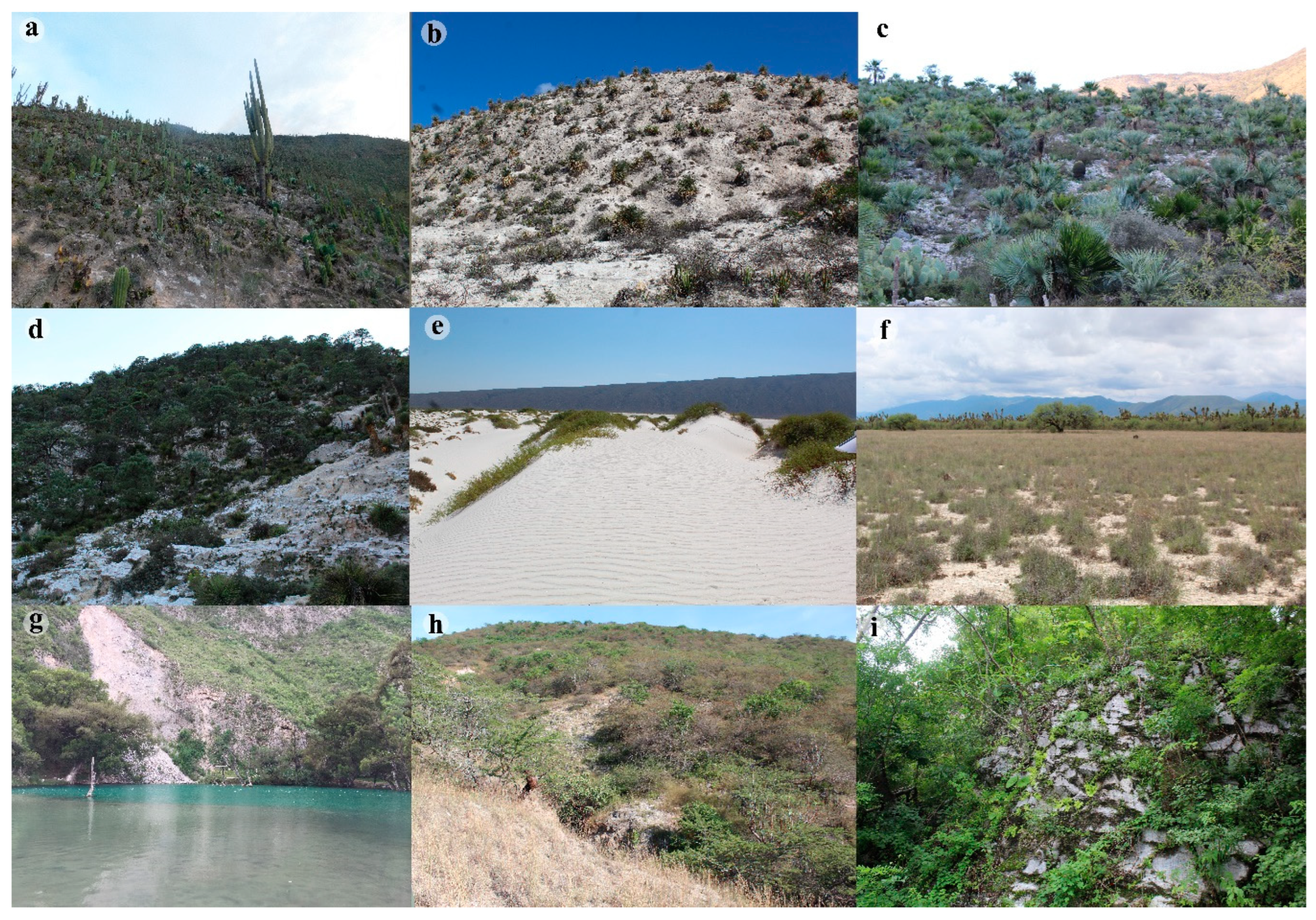
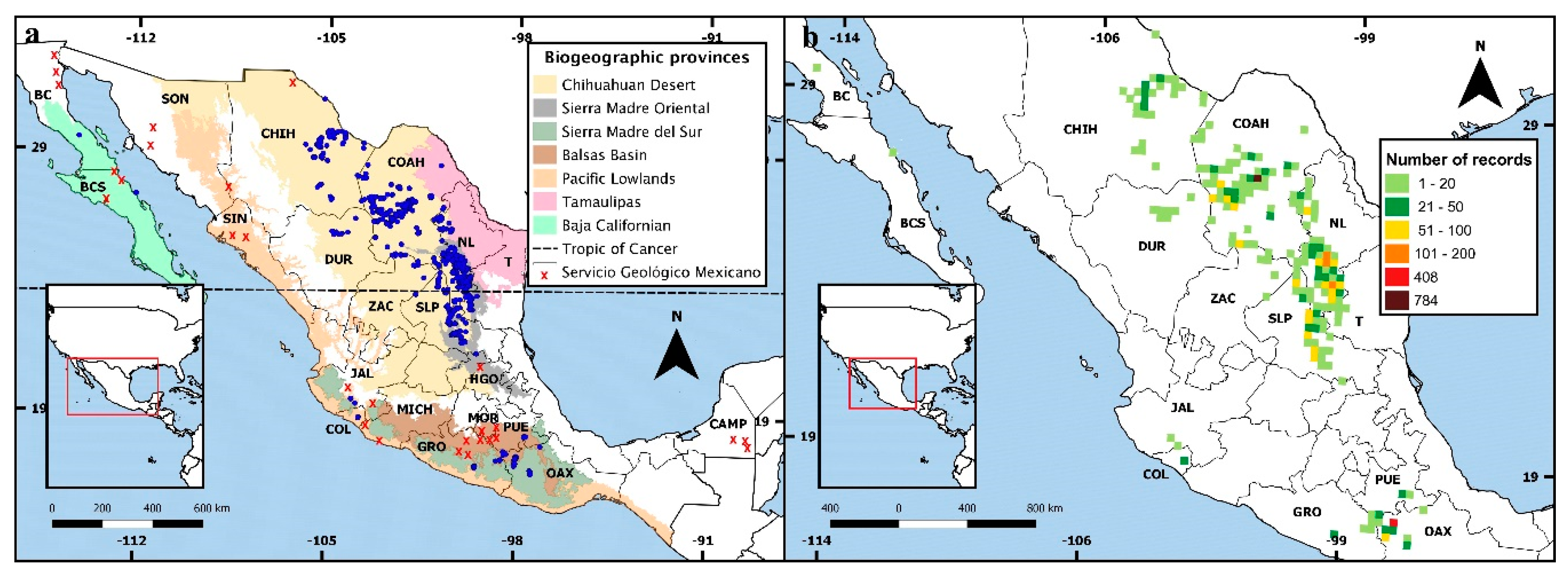
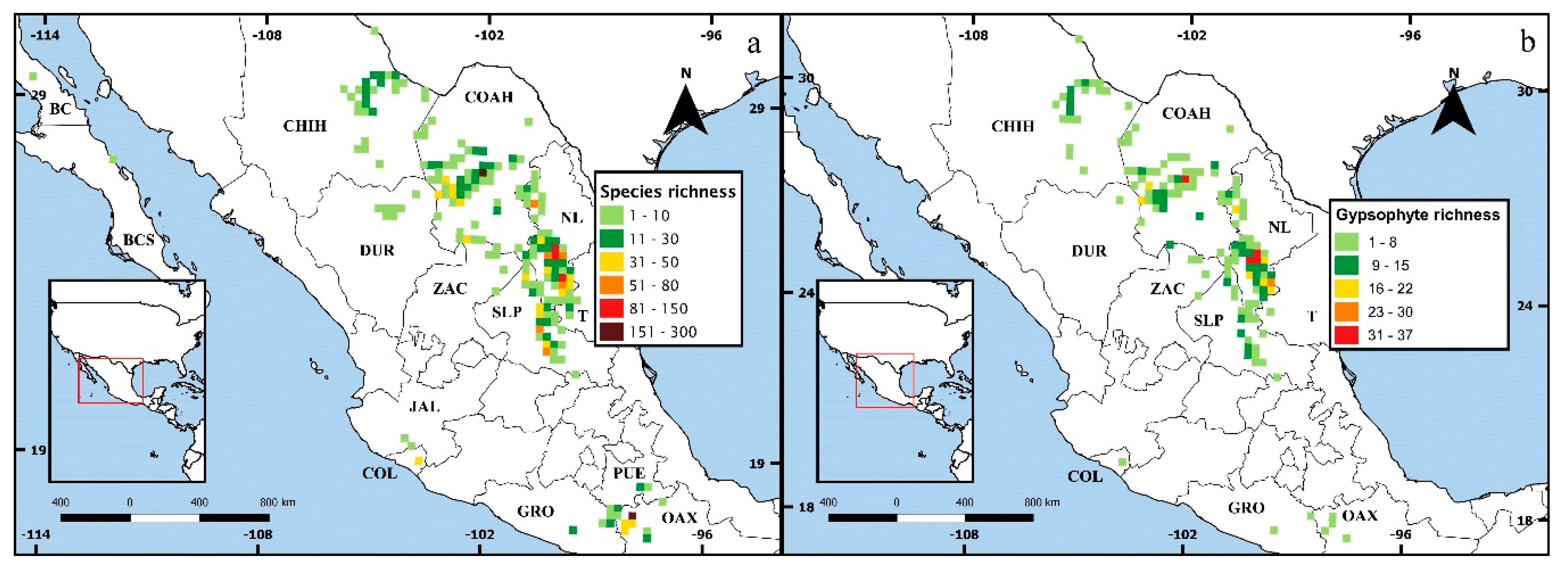
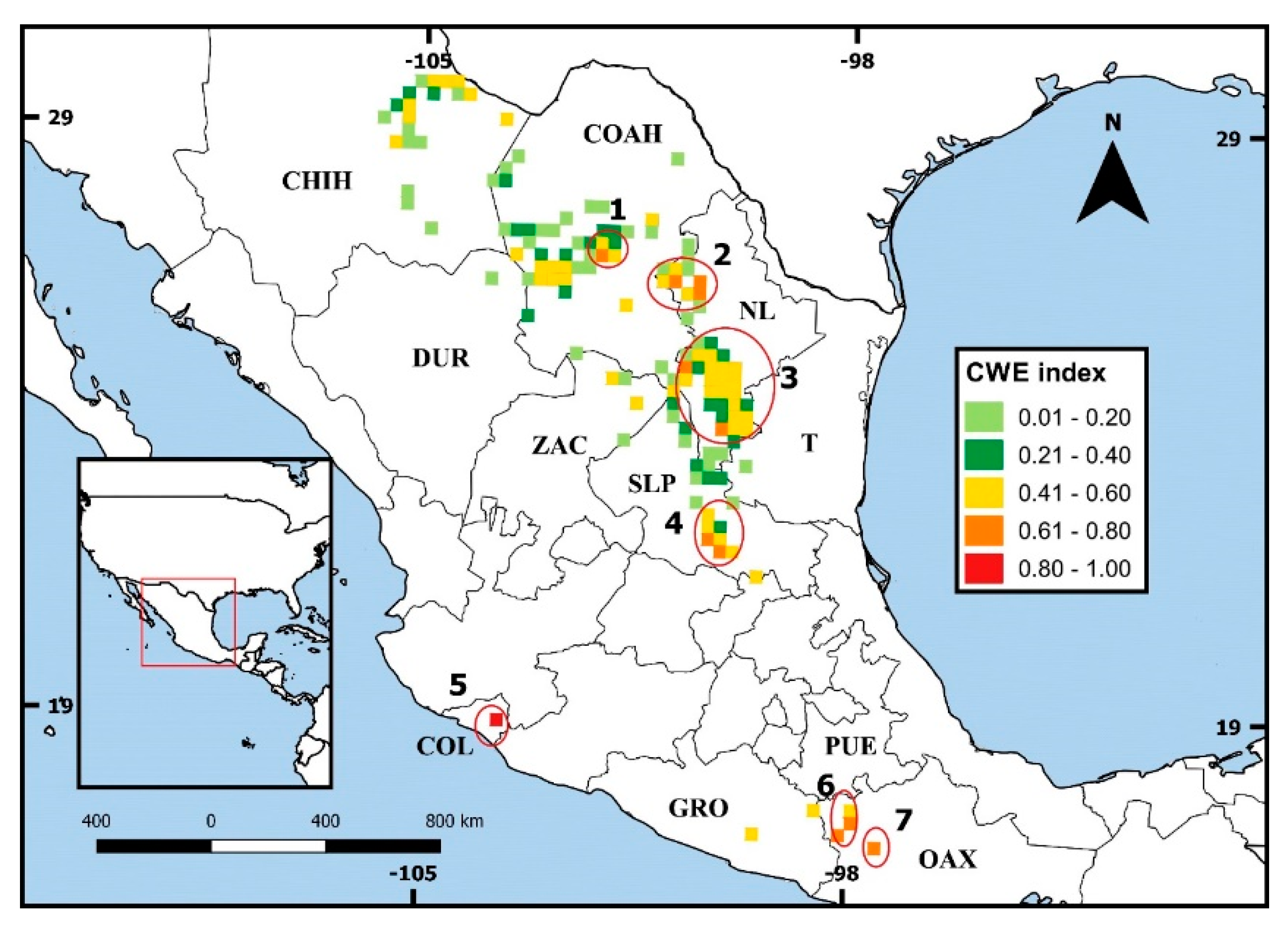
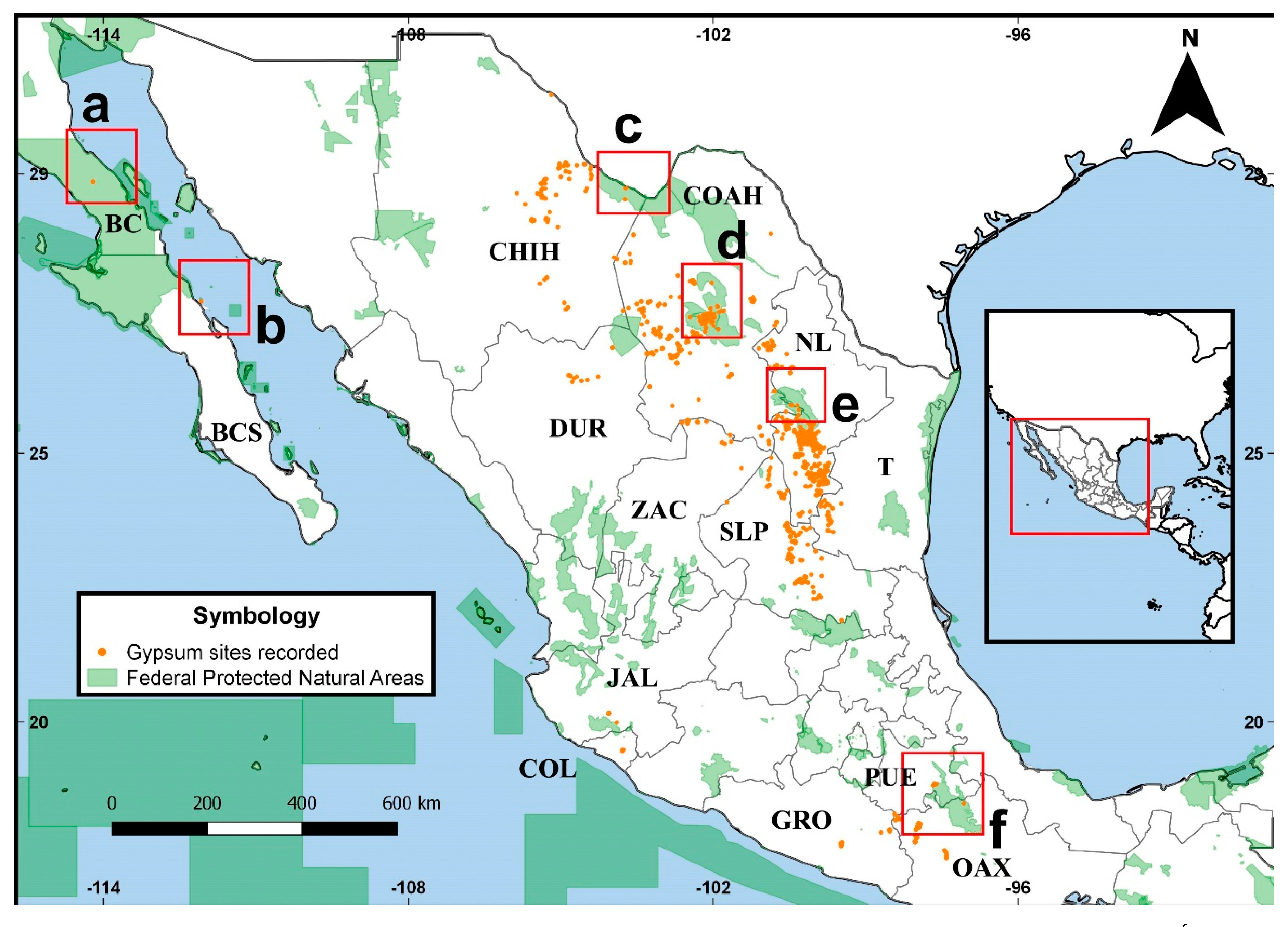
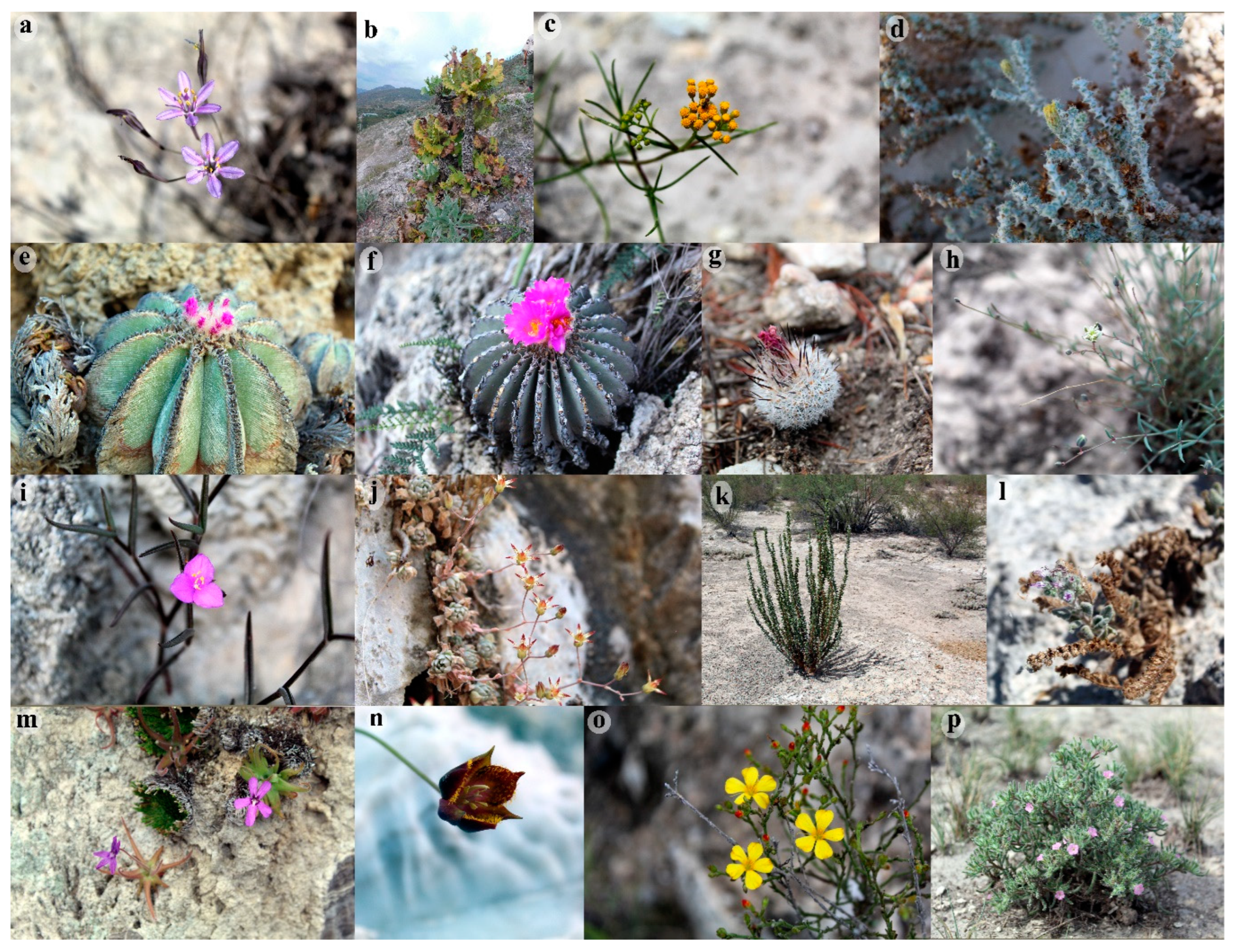
| Endemism Center | Supporting Species |
|---|---|
| 1 Cuatro Ciénegas Basin | Amaranthaceae: Tidestromia rhizomatosa I.M. Johnst.; Asteraceae: Erigeron cuatrocienegensis G.L. Nesom, Gaillardia gypsophila B.L. Turner, Haploesthes robusta I.M. Johnst., Solidago gypsophila G.L. Nesom, Xanthisma restiforme (B.L. Turner) D.R. Morgan and R.L. Hartm., Xylothamia truncata G.L. Nesom; Cactaceae: Ancistrocactus pinkavanus García-Mor., Gonz.-Bot. and Rodr. González; Euphorbiaceae: Euphorbia scopulorum Brandegee; Gentianaceae: Sabatia tuberculata J.E. Williams; Poaceae: Bouteloua johnstonii Swallen, Sporobolus spiciformis Swallen. |
| 2 Mina, Nuevo León | Asteraceae: Erigeron heleniae G.L. Nesom; Boraginaceae: Cryptantha geohintonii B.L. Turner; Caryophyllaceae: Drymaria pattersonii B.L. Turner; Ehretiaceae: Tiquilia tuberculata A.T. Richardson; Polemoniaceae: Giliastrum gypsophilum (B.L. Turner) J.M. Porter; Solanaceae: Chamaesaracha geohintonii Averett and B.L. Turner. |
| 3 Galeana-Aramberri-Zaragoza | Asparagaceae: Jaimehintonia gypsophila B.L. Turner; Asteraceae: Ageratina gypsophila B.L. Turner, Erigeron gypsoverus G.L. Nesom, E. pattersonii G.L. Nesom, Helianthella gypsophila B.L. Turner, Heterotheca gypsophila B.L. Turner, Hieracium gypsophilum B.L. Turner, Isocoma gypsophila B.L. Turner, Sanrobertia gypsophila B.L. Turner, Tridax hintoniorum B.L. Turner, Verbesina aramberrana B.L. Turner, V. hintoniorum B.L. Turner, V. zaragosana B.L. Turner; Boraginaceae: Antiphytum hintoniorum L.C. Higgins and B.L. Turner, Cryptantha gypsites I.M. Johnst.; Cactaceae: Aztekium hintonii Glass and Fitz Maurice, Geohintonia mexicana Glass and Fitz Maurice, Rapicactus beguinii subsp. hintoniorum (A.Hofer) Lüthy, R. booleanus (G.S.Hinton) D.Donati, R. zaragozae (Glass and R.A.Foster) D.Donati, Turbinicarpus hoferi Lüthy and A.B. Lau; Campanulaceae: Calcaratolobelia margarita (E. Wimm.) Wilbur, C. pringlei (B.L. Rob.) Wilbur; Caryophyllaceae: Arenaria hintoniorum B.L. Turner; Commelinaceae: Callisia hintoniorum B.L. Turner, Gibasis gypsophila B.L. Turner; Crassulaceae: Sedum booleanum B.L. Turner; Cyperaceae: Carex gypsophila Reznicek and S. González; Euphorbiaceae: Euphorbia correlli M.C. Johnst., E. neilmulleri M.C. Johnst.; Fabaceae: Dalea gypsophila Barneby, Dermatophyllum juanhintonianum (B.L. Turner) B.L. Turner; Frankeniaceae: Frankenia margaritae Medrano; Hydrophyllaceae: Phacelia hintoniorum B.L. Turner, P. vossii N.D. Atwood; Iridaceae: Sisyrinchium microbracteatum G.L. Nesom; Lamiaceae: Hedeoma ciliolata (Epling) R.S. Irving, H. pusilla (R.S. Irving) R.S. Irving, Salvia gypsophila B.L. Turner, Scutellaria hintoniorum Henrickson, S. lutilabia T.M. Lane and G.L. Nesom; Lentibulariaceae: Pinguicula immaculata Zamudio and Lux, P. nivalis Luhrs and Lampard, P. rotundiflora Studnička; Liliaceae: Calochortus marcellae G.L. Nesom; Linaceae: Linum gypsogenium G.L. Nesom, L. modestum C.M. Rogers; Namaceae: Nama hitchcockii J.D. Bacon; Oleaceae: Menodora gypsophila B.L. Turner, M. hintoniorum B.L. Turner; Onagraceae: Oenothera stubbei W. Dietr., P.H. Raven and W.L. Wagner; Orobanchaceae: Agalinis gypsophila B.L. Turner, Castilleja galehintoniae G.L. Nesom; Papaveraceae: Hunnemannia hintoniorum G.L. Nesom; Poaceae: Muhlenbergia jaime-hintonii P.M. Peterson and Valdés-Reyna; Polygalaceae: Polygala oedophylla S.F. Blake; Polygonaceae: Eriogonum fimbriatum W.J. Hess and Reveal; Pteridaceae: Gaga hintoniorum (Mendenh. and G.L. Nesom) F.W. Li and Windham; Rubiaceae: Galium dempsterae B.L. Turner, G. juniperinum Standl.; Scrophulariaceae: Leucophyllum alejandrae G.L. Nesom, L. hintoniorum G.L. Nesom |
| 4 San Luis Potosí | Asteraceae: Neonesomia johnstonii (G.L. Nesom) Urbatsch and R.P. Roberts, Tridax candidissima A. Gray, Verbesina potosina B.L. Rob.; Iridaceae: Sisyrinchium zamudioi Espejo, López-Ferr. and Ceja; Lentibulariaceae: Pinguicula gypsicola Brandegee, P. takakii Zamudio and Rzed.; Liliaceae: Calochortus mendozae Espejo, López-Ferr. and Ceja; Linaceae: Linum macradenium Brandegee |
| 5 Colima | Crassulaceae: Graptopetalum glassii Acev.-Rosas and Cházaro; Lentibulariaceae: Pinguicula colimensis McVaugh and Mickel |
| 6 Oaxaca-Mixteca | Bromeliaceae: Hechtia gypsophila López-Ferr., Espejo and Hern.-Cárdenas; Crassulaceae: Echeveria subcorymbosa Kimnach and Moran; Lentibulariaceae: Pinguicula pygmaea Rivadavia, E.L.Read and A.Fleischm. |
| 7 Oaxaca-Teita | Asparagaceae: Xochiquetzallia magnifolia García-Mend. and J.Gut.; Asteraceae: Mixtecalia teitaensis Redonda-Mart., García-Mend. and D. Sandoval; Cactaceae: Cephalocereus parvispinus S. Arias, H. J. Tapia and U. Guzmán |
Disclaimer/Publisher’s Note: The statements, opinions and data contained in all publications are solely those of the individual author(s) and contributor(s) and not of MDPI and/or the editor(s). MDPI and/or the editor(s) disclaim responsibility for any injury to people or property resulting from any ideas, methods, instructions or products referred to in the content. |
© 2023 by the authors. Licensee MDPI, Basel, Switzerland. This article is an open access article distributed under the terms and conditions of the Creative Commons Attribution (CC BY) license (https://creativecommons.org/licenses/by/4.0/).
Share and Cite
Ortiz-Brunel, J.P.; Ochoterena, H.; Moore, M.J.; Aragón-Parada, J.; Flores, J.; Munguía-Lino, G.; Rodríguez, A.; Salinas-Rodríguez, M.M.; Flores-Olvera, H. Patterns of Richness and Endemism in the Gypsicolous Flora of Mexico. Diversity 2023, 15, 522. https://doi.org/10.3390/d15040522
Ortiz-Brunel JP, Ochoterena H, Moore MJ, Aragón-Parada J, Flores J, Munguía-Lino G, Rodríguez A, Salinas-Rodríguez MM, Flores-Olvera H. Patterns of Richness and Endemism in the Gypsicolous Flora of Mexico. Diversity. 2023; 15(4):522. https://doi.org/10.3390/d15040522
Chicago/Turabian StyleOrtiz-Brunel, Juan Pablo, Helga Ochoterena, Michael J. Moore, Juvenal Aragón-Parada, Joel Flores, Guadalupe Munguía-Lino, Aarón Rodríguez, María Magdalena Salinas-Rodríguez, and Hilda Flores-Olvera. 2023. "Patterns of Richness and Endemism in the Gypsicolous Flora of Mexico" Diversity 15, no. 4: 522. https://doi.org/10.3390/d15040522
APA StyleOrtiz-Brunel, J. P., Ochoterena, H., Moore, M. J., Aragón-Parada, J., Flores, J., Munguía-Lino, G., Rodríguez, A., Salinas-Rodríguez, M. M., & Flores-Olvera, H. (2023). Patterns of Richness and Endemism in the Gypsicolous Flora of Mexico. Diversity, 15(4), 522. https://doi.org/10.3390/d15040522






